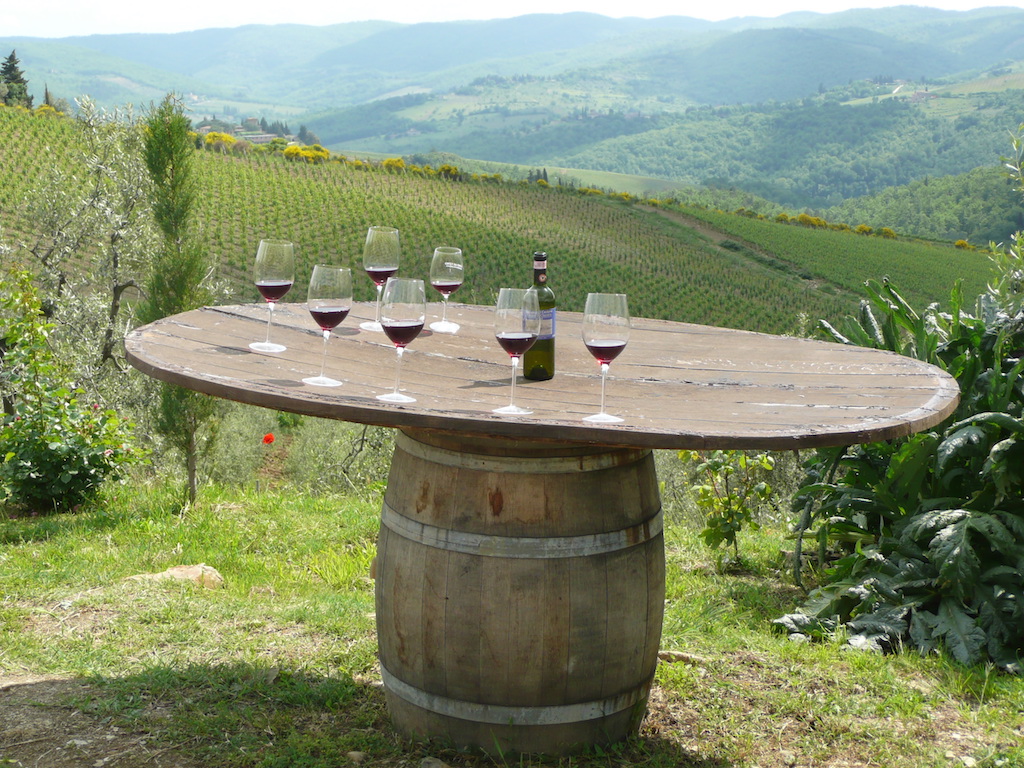Wine tours in Tuscany - About Angie - +39 3333185705 - angie.chianti@gmail.com
Exploring the essence of Chianti’s landscape through its wine offers an unparalleled journey into one of Italy’s most cherished viticultural treasures. The Chianti wine taste is as diverse and layered as the region itself, where each sip reveals a story of sunlit vineyards, artisanal craftsmanship, and the harmonious blend of tradition and nature. Sangiovese, the heart and soul of Chianti wine, paints a palatable picture of Tuscany’s rolling hills, offering a spectrum from vibrant cherry notes to deep, earthy undertones. This grape, adaptable yet distinctive, encapsulates the varied terroir of Chianti’s sub-regions, each contributing to the multifaceted profile of Chianti wines.
The grape: Sangiovese
Sangiovese, the grape from which Chianti is made, is a grape that creates fruity, juicy wines with strong cherry notes and high acidity. But of course it is never that simple; there are many quality levels ranging from inexpensive to premium, all adding a different voice and personality to this unique wine.
Chianti wine tasting is not merely about appreciating the wine’s flavor but understanding its relationship with the Tuscan soil, climate, and winemaking philosophy. From the robust body and refined elegance found in a bottle of Chianti Riserva to the lively, fruit-forward character of Chianti Colli Fiorentini, the experience is an odyssey of senses. It’s an invitation to explore the nuances that make each Chianti wine unique, from the vineyard to the glass.
Chianti wine taste and smell
The best way to experience the authentic Chianti wine taste is to visit the vineyards nestled in Tuscany’s heartlands. Here, surrounded by the beauty of nature and the legacy of centuries-old winemaking traditions, one can truly appreciate the art and science behind every bottle. Tasting sessions in these vineyards or at local enotecas in Florence offer not just a glimpse, but a deep dive into the world of Chianti wine, enhanced by the expertise of sommeliers and winemakers who share their passion and knowledge generously.
When tasting a Chianti wine, the conditions come into consideration. Has it just been opened or has it had chance to breathe, are you having it with food or without. I recently opened a Chianti Riserva 2011 and decided to start the tasting when it was fresh out of the bottle. At first sip the primary fruit aromas were struggling to deliver. The secondary notes of oak were coming through but in a somewhat flat manner.
I decided to wait half an hour, allowing the wine chance to breathe brought out the true potential of the bottle. The mouth gripping tannins suddenly softened, and the balanced acidity completed perfectly the ripe cherry and raspberry. The tertiary aromas flourished both on the nose and the palate. Black pepper with delicious notes of bitter espresso and sweet spice as well as dried prune and fig, with hints of fresh herb. Giving the wine chance to rest and breathe allowed the complexity of this wine time to develop and express itself.
A wine for food: the perfect food pairing
Moreover, Chianti’s affinity for food – its ability to complement and be complemented by Tuscan cuisine – elevates the tasting experience. The wine’s acidity and tannins harmonize with the rich flavors of local dishes, proving that Chianti wine tasting is as much about culture and connection as it is about the wine itself.
And then I sat down to eat, and this is when Chianti wine really comes into its own. This is a wine, with its sharp acidity and gripping tannins, that is made for food. Hearty, earthy meals filled with meat and tomato bring out the flavors of the wine. Chianti’s high acidity stands up to the natural acidity of tomatoes. The coarse tannins soften the meat and bring out its succulent flavors.
Just as perfect as pairing is the classic ‘Tagliere’, a wooden board piled high with mouth watering Italian cheese, salami and prosciutto. The salty meat and creamy cheese drizzled with sweet dried fruit conserve or honey all bring to the forefront the rich and fruit flavors, whilst also softening and balancing the wine.
In summary, the Chianti wine taste encapsulates the essence of Tuscany, offering a palate of experiences that range from the sensory to the soulful. Whether you’re a seasoned connoisseur or new to the world of wines, exploring Chianti’s vineyards and wines, particularly through visits to the best Chianti wineries or a Chianti wine tour, is a journey worth taking, one that promises to enrich your understanding and appreciation of Italian wines.
All the flavors of the wine suddenly make sense as they resonate around you. Balsamic, oregano, coffee, pepper, fresh cherry; all flavors integral to Italian life, and all to be found in a beautifully balanced and well-rounded glass of Chianti.






